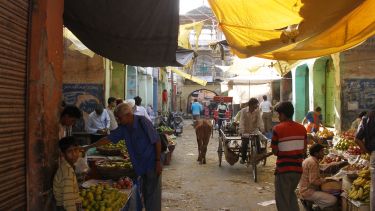India’s domestic food production is capable of supplying adequate micronutrients to its growing population in spite of water and land constraints, but achieving this will require a shift away from the current focus on rice and wheat and towards vegetables, fruit and lentils.
India’s population is projected to grow by 250 million people, reaching 1.6 billion, by 2050. Under a business-as-usual food production trajectory, India will remain at risk of severe micronutrient deficiencies, affecting physical and mental development, disease and disability, productivity and quality of life.
Writing in Nature Food, Damerau and colleagues investigate the extent to which food production in India has the capacity to supply micronutrient needs at the population level without lowering energy intake, taking into account land and water constraints.
Transforming India’s domestic food production for nutrition is increasingly constrained by the natural resource base. Groundwater availability is coming under increasing pressure in many parts of the country, with agricultural production accounting for 90% of freshwater usage, while much of the available arable land is already under cultivation. Under its nationally determined contribution to the UN’s Framework Convention on Climate Change, India’s agriculture sector will also have to find ways to limit greenhouse gas emissions.
The analysis by Damerau and colleagues integrates a range of data, including commodity-specific land availability and water footprints, and household food supplies and nutrient conversions, in a linear optimization modelling framework. Given the size and diversity of India’s agro-ecological and natural resource endowments, they take a regional approach. The optimization model maximizes micronutrient output from national food supply by allocating regional land and water resources as efficiently as possible. As resources are likely to become more constrained over time, Damerau and colleagues also carry out the optimization under increasingly stringent regional land and water constraints until the constraints become too severe to supply adequate energy at the population level. This provides an indication of the environmental limits of future capacity to supply adequate nutrition. Greenhouse gas emissions from each optimized scenario are also calculated.
Damerau and colleagues confirm that the baseline Indian diet fails to meet estimated average requirements (EARs) for several key micronutrients, and that an optimized food supply using the current natural resource base as efficiently as possible is able to meet or exceed all EARs while reducing greenhouse gas emissions by 26%. The optimized supply is characterized by large reductions in rice and wheat production (and consumption), substantial expansions in vegetables, fruit and lentils, and improved quality and quantity of feed, supporting an expansion of animal-source food supply. The supply optimized for micronutrient intake is presented as a gauge of technical feasibility and ‘direction of travel’ rather than a realistic diet for the medium run.
The authors point out that their optimization results indicate the capacity for a transformed agriculture sector to not just meet, but substantially exceed micronutrient EARs in India. Thus, there is plenty of scope to achieve more modest alterations to food production and dietary patterns along that direction of travel that nevertheless meet most EARs. Exploring future natural resource constraints while meeting basic nutritional requirements, the authors find that there is scope for reducing per capita irrigation requirements by up to 40% nationally (varying by region) when focusing on irrigation alone, cropland use by up to 27% when focusing on land alone, and irrigation by 16% and cropland by 20% when both are considered jointly. Micronutrient EARs would continue to be met under the constrained scenarios, with the exception of iron and vitamin B12 under the most constrained scenario of both land and water.
These results indicate that the Indian food system is capable of supplying the nutritional needs of the population even in the face of looming natural resource limitations. The findings support the view that, for sustainable and healthy diets, the food system should transition away from rice and wheat towards foods capable of supplying nutrients in a more resource-efficient manner, particularly vegetables, but also fruit and whole grains.
Though the results are a cause for optimism, their realization will require a paradigm shift. There have been some movements in policy (such as pilots of coarse ‘nutri’-grains in the Public Distribution System), but the rice and wheat-centric focus is deeply embedded. There is a need for nutrition-sensitive, rather than exclusively commercially oriented, horticultural policy in India to plan the needed improvement in fruit and vegetable intake, and for research that can underpin such a transition. More research attention must be focused on demand-side factors and levers that influence consumption and behaviour change.
Inequality poses major challenges for this kind of research. A focus on national diet and nutrition data can mask large variations across the population in foods that underpin the optimized food supply, such as fruit and vegetable intakes. Special attention to vulnerable sections of the population will be of vital importance in fulfilling India’s commitment to leaving no one behind.
This comment piece was originally published in Nature Food by Professor Bhavani Shankar, Professorial Research Fellow in Food and Health at the Department of Geography and Institute for Sustainable Food member.


